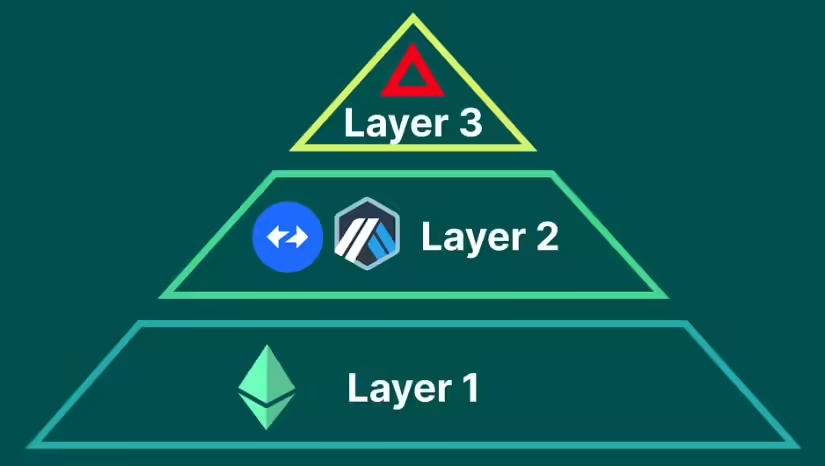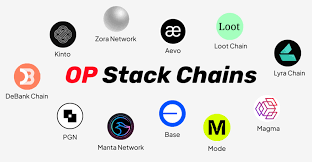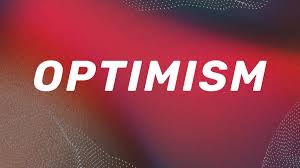Optimism is charting a bold course with its plans to introduce Layer-3 protocols, setting a new standard for Ethereum scaling solutions. By integrating the Optimism Sequencer and embracing modular blockchains, it is redefining what’s possible in the realm of blockchain scalability.
The blockchain industry’s relentless evolution sees developers on a quest for enhanced scalability and functionality of decentralized applications (dApps). Amidst this dynamic backdrop, it stands out by announcing its intention to elevate blockchain throughput. This move involves onboarding layer-3 (L3) applications atop its OP Stack, leveraging blockchain infrastructure advancements and Optimistic rollups to push the boundaries of what’s achievable.
At the heart of Optimism’s strategy for its Superchain ecosystem lies a vision to knit together a network of interconnected layer-2 (L2) chains. These chains, sharing an open-source technology stack and contributing revenue to the Optimism Collective, embody a collaborative ethos. This strategy not only showcases protocol’s governance model but also highlights the versatility of the OP-Stack, empowering developers to craft solutions that meet diverse user needs.
As the ecosystem flourishes, so does the demand for technology that’s both flexible and customizable. This growing demand underscores protocol’s commitment to democratizing blockchain technology, making it more accessible to a wide array of developers and consumers by nurturing the L3 ecosystem.
Welcoming L3s to the Superchain
Optimism’s Superchain is poised to broaden its scope by integrating layer-3 (L3) protocols. These L3s, which are built atop L2 networks, promise to elevate the ecosystem with their advanced solutions for scaling, performance, interoperability, customization, and cost efficiency. By inviting L3 developers to innovate on the OP Stack, it is laying the groundwork for a collaborative framework that enhances blockchain interoperability and introduces Rollup-as-a-service, setting the stage for future scalability breakthroughs.
Eligibility and Benefits for L3 Builders

L3 protocols that opt to build on the OP Stack and contribute a portion of their revenue to the Optimism Collective stand to gain a suite of benefits, fostering a vibrant community of builders.
- Retro Funding: L3 builders have the opportunity to tap into Retro Funding programs, receiving financial support to fuel their development endeavors, courtesy of Optimism Grants.
- Airdrops: L3 projects may find themselves eligible for Airdrops, enabling them to distribute tokens to their communities and foster greater engagement.
- Superchain Developer Grant Programs: L3 teams are encouraged to apply for Grants, which can provide substantial support for their development projects within the Superchain ecosystem.
While L3s will integrate into the Superchain, they might face certain limitations in features like interoperability compared to standard OP Stack configurations. Network is committed to clarifying these nuances shortly, ensuring transparency and fostering understanding within the blockchain interoperability domain.
Custom Gas Tokens: Streamlining L3 Onboarding
One of the most highly requested features for L3 builders is the ability to use their existing layer-2 token as the native gas token for their L3 protocol, effectively managing transaction costs. It is addressing this demand with the introduction of custom gas tokens, a feature that is currently in the final stages of development and will be rolled out soon.
The custom gas token functionality allows L3 developers to leverage their established L2 token for gas fees, simplifying the transition from L2 to L3 and reducing onboarding costs for new users. This innovation makes it more cost-effective to transition, as users can now seamlessly on-ramp to an L3 by performing a cost-effective L2 deposit transaction, thanks to the Bridge.
This innovative feature is expected to significantly lower the barriers to entry for L3 builders, making it easier for them to integrate their projects into the Superchain ecosystem.
Plasma Mode: Reducing L3 Operating Costs
In addition to custom gas tokens, protocol is also introducing Plasma Mode, an alternative data availability (DA) layer option that can help reduce the fixed overhead costs associated with operating an L3 network.
Traditionally, L2 chains have been required to post both data commitments and output roots to their settlement layer, typically the Ethereum mainnet. With Plasma Mode, L3 protocols only need to submit transactions to the L2 layer, rather than directly to the Ethereum mainnet. This reduction in data commitment and output root submissions can significantly lower the fixed costs of running an L3 chain, making it a more accessible option for deployment on the OP Stack.
Network’s recent launch of Redstone, the first OP Stack Chain with Plasma Mode, has showcased the potential of this feature to enable high-throughput applications without the need for new programming languages. The company is committed to further developing Plasma Mode, with a focus on integrating multiple data availability layers to provide L3 builders with even more flexibility and cost-saving options.
Empowering L3 Developers on the OP Stack

Ity’s efforts to support the L3 ecosystem are part of its broader strategy to make the OP Stack and the Superchain more accessible to developers with diverse needs and resources. By offering features like custom gas tokens and Plasma Mode, the company is lowering the barriers to entry for L3 builders, enabling them to leverage the power of the OP Stack to create innovative, scalable applications.
The Superchain’s open-source technology stack and revenue-sharing model with the Collective provide L3 developers with a collaborative and values-aligned environment in which to build and thrive. This ecosystem approach allows L3 projects to shape the future of scalability while benefiting from the contributions of other builders within the Superchain, underpinned by Governance and the OP-Stack.
Flexible Deployment Options for Developers
Protocol’s vision for the OP Stack and the Superchain offers developers a range of deployment options to choose from:
- Deploy dApps on an OP Stack ChainDevelopers can build their decentralized applications directly on an OP Stack Chain, taking advantage of the network’s scalability and interoperability features.
- Launch a Dedicated L2 or L3 NetworkDevelopers can harness the power of the OP-Stack to create their own L2 or L3 networks, customizing the technology to meet their unique needs and requirements.
- Collaborate with Infrastructure Partners or RaaS ProvidersDevelopers have the opportunity to collaborate with protocol’s infrastructure partners or Blockchain-as-a-Service (BaaS) providers like Zeeve to construct their blockchain solutions, making the most of the OP Stack’s capabilities and enhancing their Blockchain infrastructure.
This flexibility empowers developers to choose the deployment model that best suits their project’s needs, ensuring that the Superchain remains an accessible and inclusive ecosystem for a wide range of Web3 builders.
The Evolving Landscape of Layer-3 Networks
The emergence of layer-3 networks has sparked ongoing discussions within the blockchain community about their role and potential impact on the overall ecosystem. While some industry figures, such as Polygon CEO Marc Boiron, have expressed skepticism about the necessity of L3s, others, like Ethereum co-founder Vitalik Buterin, have suggested that L3s will serve a different purpose, providing “customized functionality” beyond just scaling.
Optimism’s embrace of the L3 ecosystem reflects its belief in the potential of these higher-layer networks to address specific use cases and user needs. By offering features like custom gas tokens and Plasma Mode, the company is positioning the OP Stack and the Superchain as a compelling platform for L3 builders to explore and experiment with.
As the blockchain industry continues to evolve, the role of layer-3 networks will likely continue to be a topic of debate and exploration. Optimism’s proactive approach to supporting the L3 ecosystem underscores its commitment to fostering innovation and driving the adoption of scalable, customizable blockchain solutions.
Conclusion: Optimism’s Vision for a Scalable and Inclusive Superchain
Optimism’s announcement to welcome layer-3 protocols into its Superchain ecosystem marks a significant advancement in the company’s mission to democratize blockchain technology for a broader audience. By introducing features like custom gas tokens and Plasma Mode, Optimism is reducing Transaction costs and lowering the barriers to entry for L3 builders, empowering them to harness the OP Stack for creating innovative, scalable, and cost-efficient applications.
The Superchain’s open-source technology stack, revenue-sharing model, and array of developer support programs create a collaborative and values-aligned environment for L3 projects to thrive. With the integration of Optimism Governance and the OP-Stack, the Optimism ecosystem is set to evolve, playing a pivotal role in enhancing scalability and promoting the widespread adoption of decentralized technologies.
Optimism’s embrace of the L3 ecosystem, highlighted by its support for Optimistic rollups and Modular blockchains, reflects its commitment to fostering innovation and providing developers with the tools and resources they need to push the boundaries of what’s possible in the blockchain space. By welcoming L3 builders to the Superchain, the company is positioning itself as a leader in the ever-evolving landscape of Ethereum scaling solutions, paving the way for a more scalable, accessible, and inclusive Web3 future.
FAQs
What is Optimism’s plan for introducing Layer-3 protocols?
Optimism aims to set a new standard for Ethereum scaling solutions by integrating the Optimism Sequencer and embracing modular blockchains, redefining blockchain scalability.
What are the benefits for Layer-3 (L3) builders in the Optimism ecosystem?
L3 builders can tap into Retro Funding programs, receive Optimism Airdrops, and apply for Superchain Developer Grant Programs, fostering a vibrant community of builders.
How does Optimism address the demand for using existing layer-2 tokens as gas tokens for L3 protocols?
Optimism is introducing custom gas tokens, allowing L3 developers to use their established L2 token for gas fees, simplifying the transition from L2 to L3 and reducing onboarding costs.
What are the deployment options for developers in the Optimism ecosystem?
Developers can deploy dApps on an OP Stack Chain, launch a dedicated L2 or L3 network, or collaborate with infrastructure partners or RaaS providers to construct their blockchain solutions.
Table of Contents
Disclaimer: This article is for informational purposes only and should not be considered financial or investment advice. Cryptocurrency investments are subject to market risks, and readers should do their own research and consult with professionals before making any investment decisions. Hash Herald is not responsible for any losses in the market.













